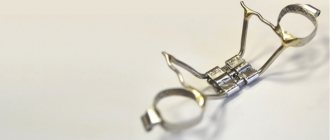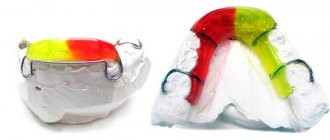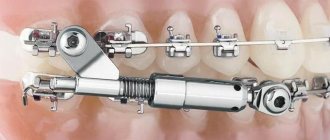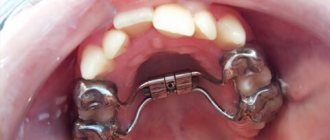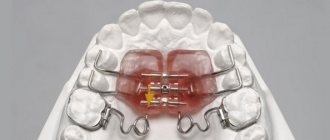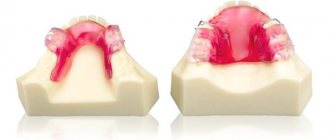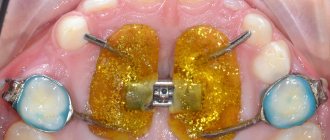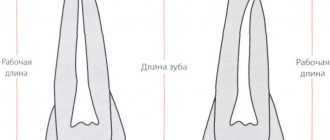The Frenkel appliance is one of the types of orthodontic appliances created to eliminate the problems of malocclusion, uneven teeth, and developmental deformities of the jaws in children.
This device allows parents from an early age to begin correcting congenital pathological disorders of the dentition (its use is allowed for children from 3-4 years old).
Features of the device design
The basis of the removable two-jaw apparatus is:
- complex metal frame;
- side (cheek) shields;
- lip pelota;
- loops for securing incisors and canines.
The frame is made of thin elastic wire, up to 1 mm in diameter, with three arcs:
- lingual;
- palatal;
- vestibular.
The arches are connected to plates made of plastic (less often metal); if necessary, screws and springs are additionally used to speed up the movement of certain teeth.
Contraindications
Bite correction using the system under consideration demonstrates an effect only when treating patients in the younger age group. In adulthood, as well as at the late stage of formation of the jaw region, the device does not produce a noticeable result. Also, the use of the device may be limited due to the presence of other abnormal types of bite development, be it cross, deep or open.
Wearing the system is safe for patients. The design is made of hypoallergenic materials, has a smooth structure and does not cause an acute feeling of discomfort associated with the restoration of the natural anatomical position of the jaws.
Manufacturing stages
Before starting to make a corrector, the dentist conducts a diagnosis. Based on its results, the form and degree of the anomaly is determined, as well as the feasibility of using the device in specific conditions. The patient's medical history is analyzed separately to identify allergic reactions to this or that type of material.
To determine the constructive bite, a wax template is used, obtained by taking impressions from the jaw area. The plaster model serves to set up the hardware basis and adjust the spring, taking into account the position of the frontal units. At the end of the laboratory work, a fitting installation is carried out, and, if necessary, the system is corrected. In addition, the doctor explains to the patient how to wear and how to care for the device.
Operating principle of the Frenkel apparatus
Most orthodontic structures have a mechanical effect on the dentition.
Frenkel developed an absolutely unique technique based on a functional effect on the regulation of muscle tone, with its help you can achieve the following results:
- reducing pressure on the cheeks and lips on the jaw in problem areas;
- positive effect on the activation of functions and natural functioning of the muscular tissues of the oral cavity;
- normalization of nasal breathing;
- the device promotes the desired position of the tongue, closing of the lips and thereby ensures the harmonious development and growth of the jaws of young patients.
Manufacturing process
The device is made on the basis of a two-jaw cast. The latter reflects the nature of the location of all teeth, alveolar processes and folds near the tongue. The final model is fixed in such a way that it forms the correct bite.
Based on the cast, the doctor determines the location of the side shields. These elements should not fit tightly to the dentition and alveolar processes. During the modeling process, wax is poured into the area where the side panels and caps will be located. The thickness of the former does not exceed 2.5 mm, the latter – 3 mm.
A special laboratory is engaged in manufacturing the base of the device. Metal arches are adjusted in the presence of the patient. The work on creating the Frenkel apparatus will be completed by polishing and grinding the plastic structural elements.
Indications for use of the Frenkel apparatus
The effective period for the treatment of children's dental pathologies is considered to be the time of their active growth (4 - 12 years).
An orthodontic appliance is used for the following pathologies:
- distal bite (strong development of the upper jaw);
- mesial bite (pushing forward of the lower teeth);
- open bite (the lower and upper dentitions do not meet, a gap is formed);
- neutral bite (insufficient development of alveolar processes);
- narrowing of the dentition;
- twisted teeth.
Treatment of malocclusion with functional devices
Standard Schoncher vestibular plates are factory produced in three sizes, which are selected depending on the width of the dental arches.
Kerbitz vestibular plates are made individually, according to jaw models fixed in the constructive bite. They are adjacent to the vestibular surface of vestibularly displaced teeth, alveolar processes, and go to the transitional fold of the mucous membrane (see Fig. 27).
A vestibular plate for eliminating distal occlusion is used to eliminate bad habits, correct vestibularly deviated upper incisors, stimulate the growth of the lower jaw and expand the upper dentition (if indicated). Based on the casts, models of the upper and lower jaws are cast and an upper wax base with bite ridges is prepared. The doctor determines and fixes the constructive bite with rollers. Models made from impressions on the bite ridges are plastered in an occluder (retainer). The first layer of wax is applied to the vestibular surface of the dentition, alveolar processes to the transitional folds of the mucous membrane and the distal surface of the last molars. The ledge between the cutting edges of the upper and lower incisors is leveled with wax. The second layer (plate) of wax is layered so that in the lateral sections of the models its thickness is greater than in the front, and corresponds to the distance of the required expansion (but not more than 2.5 mm at the transitional fold of the mucous membrane).
The wax covering the underside of the labially deviated crowns of the upper incisors is scraped off to expose the incisal edges of the upper and lower incisors. A separating layer of liquid soap or soapy water is applied to the surface of the wax. The double base plate of wax, having softened, is pressed along the vestibular surface of the models so that the future edges of the vestibular plate are immersed in the transitional fold of the mucous membrane of the upper and lower jaws. The edges of the plate end at the distal surfaces of the second primary or first permanent molars. In case of deep incisal overlap, a bite pad is modeled for the lower front teeth. The wax template of the plate is tried on diagnostic models and in the oral cavity. The line of lip closure is marked on the template and a wire ring with a diameter of 20 mm is fused horizontally into the wax of the template along the midline and mark to train the orbicularis oris muscle. The wax is replaced with plastic, processed and polished.
If the child breathes through the mouth, then one (7 mm in diameter) or several (2 mm in diameter) holes are made in the plate along the line where the lips close, which are covered with self-hardening plastic as they switch to breathing through the nose. The force of contraction from the labial and buccal muscles is transmitted by the plate to the upper anterior teeth, causing them to move along with the alveolar process to the palatal side. When the lower jaw moves, the pressure on the plate of the lower lip increases, and the unpleasant sensations force the child to move the jaw forward, which promotes its growth and enlargement of the oral cavity.
F. Ya. Khoroshilkina attached a face bow to the vestibular plate with a bite platform for the lower teeth. A rubber rod running from the ends of the arch to the hooks on the neck bandage or head cap increases pressure on the front teeth, promotes better fixation of the plate in the mouth and speeds up the treatment of the anomaly.
Vestibular plate for eliminating mesial occlusion. Plaster models are obtained, fixed in the constructive bite. Wax is layered onto the vestibular surface of the dentition and alveolar processes of the models up to the transitional fold, with thicker wax being layered on the upper jaw model and thinner on the lower jaw model. A step (ledge) is aligned between the cutting edges of the incisors. By scraping off the wax, the upper third of the vestibular surface of the crowns of the lower incisors and their cutting edges are exposed. The vestibular plate is modeled from a double plate of wax, and it is tried on models and in the oral cavity. It should fit tightly to the cutting edges and the upper third of the vestibular surface of the crowns of the lower incisors and be spaced from the upper teeth and alveolar processes at the distance required to expand the upper dentition, but not more than 2.5 mm at the transitional fold of the mucous membrane and 3.5 mm - at the teeth. The further stages of making this plate are the same as the previous one. The purpose is to eliminate a bad habit, correct the vestibular deviation of the lower incisors, and stimulate the growth of the upper jaw.
Krause's vestibulo-oral plate (Fig. 97).
It is made in the same way as a regular vestibular plate, only on the oral side an additional lingual shield (oral plate) is made near the front teeth, extending to the distal surfaces of the fangs. The lingual shield should not be adjacent to the oral surfaces of the upper anterior teeth and alveolar processes, which are deviated vestibularly. Both parts of the device (vestibular and oral) are connected with pieces of wire with a diameter of 0.8-1 mm. They go around the distal and lingual surfaces of the lower last molars, the ends are directed anteriorly and, bending in a wave-like manner, are fixed in the distal parts of the vestibular and oral plates. The purpose of the device is to eliminate distal bite, combined with open bite, caused by tongue sucking or improper swallowing.
Details of removable orthodontic appliances
Vestibular plate with oral wire grid (stop) . The oral grille is bent to the modeled vestibular plate from orthodontic wire with a diameter of 1-1.2 mm according to the drawing drawn by the doctor on the models. A piece of wire is bent in a wave-like manner, making four protrusions at the top and five at the bottom. The tops of the protrusions are placed at the necks of the upper and lower incisors on the oral side. The distal border of the protrusions (lattice-stop) runs along the center of the fangs. Using three-beak or convex-concave forceps, each protrusion is bent semicircularly to the shape of the oral surface of the anterior part of the oral cavity. Then the entire stop grid is bent ovally according to the shape of the dental arches in the transverse direction. The free ends of the wire are bent between the canine and the first primary molar vestibularly, bent distally and, bent in a wave-like manner, fixed in the wax of the vestibular plate.
The grille-support should be 1-1.5 mm from the oral surface of the teeth and alveolar processes. The further stages of making the plate are the same as the previous plates. Its purpose is to eliminate bad habits and treat combined malocclusions (sagittal with open) that developed when the tongue was inserted between the teeth.
Muehlemann propulsor (Fig. 98).
On a plaster model of the upper jaw, fixed in a constructive bite with a model of the lower jaw in the occluder, wax is layered in those areas that need to be freed from pressure (as in the manufacture of a vestibular plate). The oral plate for the lower jaw (base) and the vestibular plate for the upper jaw are modeled from wax and joined together in the anterior section of the dentition. The wax template is plastered and replaced with plastic.
When making a propulsor from self-hardening plastic, it is applied first to the oral surface of the lower jaw model, then to the vestibular surface of the upper jaw model. The plastic should tightly cover the lower third of the vestibular surface of the crowns and the cutting edges of the upper incisors. Then the occluder is closed, fixed with a rubber ring, and the vestibular part of the propulsor is molded (modeled) on the model of the upper jaw, without covering the closing surfaces of the lateral teeth. The device is polymerized under pressure in cold water, processed and polished. The purpose of the device is to eliminate bad habits, deflect the upper incisors orally, stimulate the growth of the lower jaw, and dentoalveolar lengthening in the lateral areas of the dentition.
Oral-vestibular apparatus of Malygin (Fig. 99).
On models plastered in a constructive bite with dentition separation of 3-4 mm, the boundaries of the apparatus are drawn: on the upper model, as for the palatal plate, on the lower model, as for the vestibular plate. The base of the apparatus, adjacent to all upper teeth on the palatal side, and the vestibular plate adjacent to the lower teeth are modeled from wax.
The oral and vestibular parts of the apparatus are connected to each other in the interocclusal space of the dentition. The surface of the closure of the lateral teeth is not covered with wax, and the junction of the plates is smooth inclined planes. The wax is replaced with plastic, processed and given to the doctor. Under the pressure of a single inclined plane, the upper teeth move vestibularly, and the lower front teeth move orally. According to indications, the device is equipped with upper labial pads, an oral protrusion bracket for the upper incisors, various springs for moving teeth, and supporting wire pads for the lower molars.
Purpose - elimination of mesial occlusion with deep incisal overjet, palatal inclination of the upper and vestibular inclination of the lower incisors.
The Frenkel function regulator is a removable frame double-jaw vestibular apparatus, consisting of two buccal shields covering the premolars, molars and alveolar processes from the vestibular side to the transitional fold and freeing the lateral sections of the dentition from the pressure of the cheeks, as well as vestibular (labial) pads located on the vestibular the surface of the alveolar process at the level of the roots of the incisors, pushing back the lip.
Shields and caps stimulate the growth of the jaws at the level of the roots of the teeth (in the basal part) in width and in the anterior (sagittal) direction. The regulator normalizes the closure of the lips, the position of the tongue, their relationship and the function of the dentition and jaws. There are three main types of function controllers. The first type (ΦΡ-Ι) (Fig. 100) is used to treat anomalies in neutral occlusion, distal occlusion, combined with a narrowing of the dentition and a forward shift (tilt) of the upper front teeth. The second type (ΦΡ-ΙΙ) is used for distal occlusion with a shift (tilt) of the upper incisors posteriorly (orally). The third type (ΦΡ-ΙΙΙ) is indicated for eliminating mesial occlusion.
Manufacturing of type I function regulator (ΦΡ-Ι). Models are made from the casts and plastered in a retainer or occluder in a constructive bite. The model of the upper jaw is engraved along the transitional fold in the area of the canines, first premolars, and sometimes in the area of the cusps of the upper jaw. The model of the lower jaw is engraved on both sides from the frenulum of the lower lip to the fangs in the area of the projection of the roots of the lower anterior teeth vertically down to a depth of 5 mm along the transitional fold of the mucous membrane. In the absence of three, a model of the upper jaw is engraved in the area of contact points on the closure surface. Engraving of models and subsequent drawing of boundaries and individual parts of the regulator are carried out by a doctor.
Insulation - a wax lining - is applied to the side surface of the plaster models in areas of narrowing or underdevelopment of the alveolar processes of the jaws. The thickness of the insulation is equal to the distance of the required expansion of the dentition, but not more than 2.5 mm on the alveolar processes and 3 mm on the teeth. At the site of placement of the lower labial pelots, isolation on the lower jaw model is not done.
In case of underdevelopment of the lower and upper dentition (alveolar processes) in the frontal area, labial pelots are placed in the area of both the lower and upper lips with preliminary appropriate engraving of the model and isolation to remove the upper pelots from the apical base (plaster of the model) at a distance equal to its expansion (but not more than 2.5 mm). Then the insulation is smoothed and in the lateral sections of the models the occluder is cut with a razor at the level of the interocclusal space and opened. The wire parts of the regulators are bent from orthodontic wire with a diameter of 0.9-1 mm, the ends of the parts included in the plastic are bent in a wave-like manner and placed 0.75 mm from the surface of the model or insulation. Parts of the wire parts free of plastic are located 1.5 mm from the mucous membrane (surface of the model, insulation).
A vestibular arch with activated semicircular bends in the canine area is bent onto the upper front teeth from a wire 120-150 mm long (Fig. 100, 1). The ends of the arch are bent distally (posteriorly) and slightly towards the occlusal surface of the teeth, parallel to the surface of the insulation. At the level of the intercuspal fissure of the first permanent molar, the ends of the arch are bent at a right angle towards the base of the model, the excess is bitten off, and the ends are immersed in wax. From pieces of wire 60-70 mm long, loops are bent onto the upper canines, starting from the middle of the vestibular surface of the canine crown. The end of the loop is 1-1.5 mm away from the tooth.
Between the lateral incisor and the canine, a bend is made in the oral direction, they go around the neck of the canine, retreating from the edge of the gum by 1 mm. The distal arm of the loop is placed in the space between the upper canine and the first premolar. Then the wire is bent distally, without touching the vestibular side of the first premolar, and, having bent the end, it is positioned in a wave-like manner parallel to the insulation surface. The loop should enter the side shield at the level of the surface where the teeth meet (Fig. 100, 2). From a wire 150-180 mm long and 1.2 mm in diameter, a palatal clasp is bent in the posterior part of the hard palate (Fig. 100, 3), connecting the vestibular shields and transmitting pressure to the first upper permanent molars in the distal direction.
Having marked the middle of the wire, use round pliers to bend a ring-shaped or regular protrusion with a diameter of 9-10 mm, placing it 1 mm from the surface of the palatine vault. The ends of the clasp are roundly bent forward along the slope of the palate to the fifth tooth and bent over the closure surface between the fifth and sixth teeth to the vestibular side, pressing against the medial surface of these teeth. Then they bend upwards in the form of U-shaped fixing brackets. The free ends of the brackets (stoppers) are bent towards the intertubercular groove of the sixth tooth, moving them away from the surface of the teeth to the distance required for dentoalveolar lengthening. The stoppers prevent injury to the gums when the regulator is tipped over and serve as its support on the closure surface.
To fix the lower labial pelotes, take a piece of wire 30 mm long, bend the bracket in the shape of the labial frenulum, and bend the ends horizontally 7-8 mm below the necks of the lower incisors. The ends of the wire are flattened. The bracket is fixed to the jaw model in the area of the frenulum of the lower lip with sticky wax. The paired parts connecting the lip pads with the cheek shields are bent from wire 50-60 mm long in the anterior section parallel to the ends of the bracket, 1 mm below them. Then they bend upward and bayonet-like in the distal direction and near the edge of the wax plate in the vestibular direction. The last bend is made almost at a right angle in the distal direction and its end is placed parallel to the surface of the wax. At the level of the middle of the neck of the first permanent molar, a bend is made at a right angle towards the wax. Excess wire is bitten off, and its end 2-2.5 mm long is immersed in wax.
Regulating parts of orthodontic appliances
If it is necessary to vestibular deviation of the lower incisors and move the lower jaw to the position of constructive bite, bend the lingual arch (see Fig. 100, 4). First, an arc template is bent from the ligature wire, marking the wire annealing areas on it. Having straightened the template, they bite off the required piece of wire along it, transfer the marks of the annealing places onto it, and anneal the wire along them. The lingual arch should be rigid in the area of the middle of the ascending curves (loops) in the sublingual region. The middle part of the arch adjacent to the tubercles of the lower front teeth is bent. Having reached the distal surfaces of the canines, the arch is lowered to the bottom of the mouth and at the level of the roots of the first premolars it is bent roundly (in loops), returning the ends to the contact points of the canines with the premolars, and bent through the closure surface between these teeth to the labial side. Then the wire is bent back, without touching the labial surface of the lateral teeth, parallel to the surface of the model. Stepping back from the last bend by 10-15 mm, the ends of the wire are inserted into the wax insulation of the model. When closing the mouth, the loops of the lingual arch should direct the lower jaw into the position of constructive bite and not injure the mucous membrane of the alveolar process during distal shift of the lower jaw.
After manufacturing the metal structures (bleaching the annealed areas), they are fixed with adhesive wax to the model in places that are not covered with plastic. The cut area of the wax insulation pad on the models is filled with hot wax and glued together. Having treated the model with an insulating agent (for example, isokol) and degreased the parts of the wire parts included in the plastic with monomer, occlusal pads, side shields and pelota are formed from pre-mixed self-hardening plastic dough to the consistency of sour cream and “ripened” dough. Buccal shields are placed in the lateral sections of the dentition: the anterior border is the medial edge of the fourth tooth, the upper and lower borders are along the deep part of the transitional fold of the mucous membrane (taking into account the engraving of the models), the posterior border is 2-3 mm distal to the second molar. The buccal shields are modeled (molded) according to the shape of the alveolar processes, made slightly concave along the line of occlusion and rounded in the posterior areas. The thickness of the shields (2.4-2.5 mm) consists of the thickness of the wire parts and two layers of plastic covering them on both sides (0.75 mm each). Labial pelota of the same thickness are made in the form of a parallelogram with rounded corners, length from the frenulum of the lip to the middle of the lower canine and to the medial surface of the upper canine. The upper edge of the pelota is made thinner, positioning it 5 mm below the necks of the lower incisors, and the lower edge is thickened and brought vertically to the bottom of the transitional fold of the mucous membrane (taking into account the engraving of the model).
According to indications, occlusal overlays are made to separate the bite, directed from the shields to the surfaces of the teeth. These onlays, made of plastic, must have imprints of the tubercles and fissures of the closure surface of the teeth of a healthy dentition (normal) and a smooth surface facing the teeth of the deformed dentition, therefore the fissures of the lateral teeth of the deformed dentition on the model are filled with hot wax to the level of the tops of the tubercles. To increase the strength of the occlusal pads, they are bent from wire 40 mm long. The middle part of the onlay is placed in the longitudinal groove of the first permanent molar. The places where the wire bends on the medial surface of the tooth are marked and bent vestibularly, then down parallel to the surface of the tooth and the ends, bent to the sides, are fixed in the plastic of the shields.
Sometimes the overlays are reinforced with a metal mesh made of wire with a diameter of 0.1-0.2 mm and a cell size of 0.2-0.3 mm. The mesh is applied on both sides to the wax covering the occlusal surfaces of the teeth so that it protrudes vestibularly by 2 mm. The excess is cut off. The dough of the self-hardening mass is first applied to the ends of the wire parts, the reinforcing mesh of the overlays is coated on both sides, they are placed in their places, and the lower lateral teeth are covered with plastic. Then the occluder is closed, pelota, occlusal pads, and cheek shields are formed, modeling them with hands moistened with water. It is necessary to ensure that the plastic is distributed in an even layer and does not drain from the tubercles. The surface of the modeled apparatus is smoothed with cotton wool moistened with a monomer of self-hardening plastic. The occluder is fixed with several rubber rings and placed in a polymerizer. The lid is closed hermetically, the pressure is raised to 202.6-253.3 kPa (2-2.5 atm) (without heating) and the apparatus is kept in the polymerizer for 45-50 minutes. Then the pressure is gradually reduced to atmospheric pressure and the apparatus is removed. The wax is washed off with hot water, freed from the models, excess plastic and the fixing ends of the wire parts protruding from the plastic are cut off. The device is processed, polished and handed over to the doctor.
For the treatment of distal occlusion, Frenkel proposed three types of function regulators of type I (ΦΡ-Ia, FR-Iв, ΦΡ-Ic) and one type of type II (ΦΡ-ΙΙ). Function regulators of the first type. FR-Ia - the loop of the palatal clasp is replaced with a U-shaped bend to increase rigidity. Designed to eliminate neutral occlusion with deep incisal overjet, protrusion of the upper anterior teeth and retrusion of the dentoalveolar arch in the anterior part of the lower jaw, distal occlusion with a sagittal gap of up to 5 mm and a shift (when closing) of the lateral teeth by less than half the width of the premolar crown.
FR-Iv - the lingual arch is replaced with a lingual plastic shield placed in the sublingual region from the right to the left premolars. The upper edge of the shield does not reach the edge of the gum by 2-3 mm, the lower edge goes along the bottom of the oral cavity. The lingual shield is attached with wire parts to the buccal shields between the premolars. It contains two activated protraction springs for vestibular deviation of the lower incisors. Designed to eliminate distal bite with protrusion of the upper anterior teeth in the presence of a sagittal gap of up to 7 mm and a shift of the lateral teeth by half the width of the crown of the first premolar.
ΦΡ-Ic - in design it corresponds to FR-1v, but expansion screws are installed in the side shields at the level of the neck and middle of the crown of the first lower molar. The lower segment, in which the labial pelota, lingual shield and medial parts (ends) of two screws (right and left sides) are fixed, are cut out sectorally. Unscrewing the screws moves the lower segment anteriorly and the upper segment posteriorly, which helps the distal movement of the upper teeth. It is used for the treatment of distal and other anomalies combined with distal occlusion, where regulators of the ΦΡ-Ia and FR-1b types are not indicated.
The function regulator of the second type ΦΡ-ΙΙ differs from ΦΡ-Ι in that a palatal arch has been added to it for protraction (medial movement) of the upper anterior teeth and the shape of the hooks (loops) on the upper canines has been changed. The palatal arch is bent from wire with a diameter of 0.7-0.8 mm and a length of 120-140 mm. The central part of the arch is bent semicircularly along the palatal surface of the upper incisors. At the distal surface of the lateral incisors, the ends of the wire are bent at an angle of 45° to the midline of the palate, repeating the shape of the alveolar process. Having retreated 10 mm, semicircular bends (loops) are bent, and the ends are returned to the teeth and bent through the occlusal surface between the canine and premolar vestibular.
The archwire should be adjacent to the mesial surface of the first premolar. Without touching the vestibular surface of the first premolars, the ends of the arch are bent posteriorly and placed parallel to the wax insulation of the model at the level of the occlusal surface of the lateral teeth. At the middle of the first permanent molars, they are bent at a right angle, the excess is bitten off, and the ends are fused into wax. Hooks (loops) for the upper fangs are bent from a wire 60-70 mm long, the shoulder covers the medial surface of the canine, then the wire is bent parallel to the vestibular surface of the canine, 2 mm above the neck of the tooth it is bent slightly upward and backward. The end is bent in a wave-like manner, positioned parallel to the surface of the wax. The loop is removed from the vestibular surface of the canine to a distance equal to half the width of the desired expansion of the dentition in the canine area.
The function regulator of the third type (type ΦΡ-ΙΙΙ) is used to eliminate mesial occlusion. The models obtained from the casts are plastered in an occluder (retainer) in the constructive bite. The model of the upper jaw is engraved, deepening the transitional fold in the area of the incisors by 5 mm. Part of the plaster is scraped off in the area of the transitional fold at the level of the apexes of the roots of the upper canines and first premolars, maintaining the direction of the slope of the alveolar process.
Labial pelots are placed 2-2.5 mm from the alveolar process and the apical base, so a wax pad (insulation) in the form of pelots is layered onto the plaster model of the upper jaw, repeating the shape of the surface of the alveolar process. Wax is also layered on the vestibular surface of the teeth and alveolar processes of the upper jaw in the area where the side shields are placed, taking into account that the shields should be no more than 2.5 mm from the alveolar process.
With reverse incisal overlapping, occlusal overlays are shown on the lower lateral teeth with a smooth (without imprints of the cusps of the teeth) surface facing the cusps of the upper lateral teeth; therefore, the fissures on the closure surface of the upper lateral teeth are filled with wax to the level of the tops of their cusps. The bracket connecting the upper labial pelota is bent from a wire 40-45 mm long. A bend is made in the middle of it, bypassing the frenulum of the upper lip, the ends of the bracket are bent in a wave-like manner, placing them horizontally at a distance of 8-10 mm from the edge of the gum and 0.75 mm from the surface of the insulation (wax) of the model. The paired parts connecting the pads with the cheek shields are bent from pieces of wire 60-70 mm long. Their front ends, bent in a wave-like manner, are placed 1 mm above the ends of the bracket, parallel to it. The wire is then bent slightly downward to the edge of the model wax (insulation) covering the upper alveolar process. Here the wire is bent in a bayonet-like manner and directed distally (posteriorly), making its section located in the thickness of the side shield flat. The distal ends are bent at the first permanent molars at a right angle, the excess is bitten off and the ends are immersed in wax at the level of the middle of the necks of the first permanent molars. The palatal arch is bent as for ΦΡ-ΙΙ, but it should not touch the upper teeth when passing through the interocclusal spaces between the canine and the first premolar, so as not to interfere with the medial movement of the upper lateral teeth. The clasp is bent in the same way as for ΦΡ-Ι, but is placed behind the distal surface of the last molars of the upper jaw, pressing it tightly against the teeth. The vestibular ends of the clasp are bent in a wave-like manner and directed medially (back to front), parallel to the surface of the wax model.
The lower labial arch is bent tightly adjacent to the lower front teeth, having previously engraved their vestibular surface to increase pressure on these teeth. At the middle of the vestibular surface of the lower canines, bends are made at right angles downwards 3-4 mm below the gingival margin. The ends are curved roundly (loop-shaped) in the distal direction. Having departed from the bend by 15-20 mm, the ends are bent at a right angle and fixed in pre-made recesses in the plaster of the lower jaw model at the level of the middle of the necks of the first permanent molars. Wire and mesh-reinforced occlusal pads are manufactured as described above. If the lower anterior teeth are crowded, the manufacture of a lingual arch is indicated to prevent their lingual tilt and better stabilize the apparatus. The arc shape and manufacturing are the same as in the first type of regulators. To expand the upper dentition, correct diastemas, vestibular deviation of the incisors, and rotate them according to indications, palatal pelots with wire springs acting in the vestibular direction, additional loops (bends) with wire grips on the palatal arch, and separate springs with their ends fixed in the buccal shields are used or labial pelotas, as well as labial pelotas on the upper and lower jaws.
Examination before physiotherapy
The appearance of the slightest signs of abnormal development of teeth in a child obliges parents to seek advice from an orthodontist.
After a visual examination, the doctor will suggest:
- take an x-ray or orthopantomogram of the upper and lower jaw;
- cure carious teeth and inflammatory processes in the oral cavity, if any.
Based on the images, the doctor will determine the type of pathology and prescribe treatment with the appropriate type of device design to eliminate the defect.
Types of Frenkel apparatus
Different pathologies require different effects on the patient’s dental apparatus. There are four types of this design:
- FR - I is used to eliminate signs of distal occlusion with protrusion of the frontal teeth of the upper jaw, and with narrowing of the dentition. They consist of palatal and lingual arches, attached with upper and lower pelota. The cheek shields are connected to the lower pads using brackets. It is located in the oral cavity so that the shields do not come into contact with the alveolar ridge.
- FR-II is used to correct excessive inclination of the upper incisors (retrusion). It differs from the first type in the type of loop capes on the fangs and the presence of double pelotes. The shields are in close contact with the dentition and the crest of the alveoli. Made from transparent material.
- FR - III eliminates progeny (excessive development of the lower jaw). The design feature is the absence of lower pelotes and the presence of a vestibular arch.
- FR - IV corrects open bite, eliminates the reasons that hinder the development of the lower jaw. There are pads for the lower lip, a vestibular arch for the upper row, and metal pads. The device also helps to separate the bite.
Duration of treatment
The timing of correction using the Frenkel orthodontic apparatus depends on the Patient’s compliance with all recommendations and regular visits to the doctor. The greatest effectiveness is observed when installed at the age of 11-14 years, that is, before the formation of a permanent position of the teeth. It takes about 4-8 months for pronounced anomalies, and the result is permanent; the functionality and aesthetics of the series are fully restored. In case of serious pathologies and a mature bite, treatment may take at least a year and a half. But the first results become noticeable after two to four months. During the entire correction period, the structure is replaced up to three times.
Price
The price of the Frenkel apparatus depends on the following factors:
- condition of the oral cavity, degree of defect;
- ongoing diagnostic and preparatory activities;
- the type of device selected for correction;
- installation features, the need for additional actions.
To make a calculation, you must contact our clinic and undergo a preliminary examination and diagnosis. Based on the data obtained, the doctor will determine the treatment tactics and name the cost of the correction.
About Us
Magenta Dental Clinic is a modern orthodontic clinic that provides treatment services and elimination of a number of dental defects. We provide our Patients with the following benefits:
- use of certified materials and equipment;
- services of highly qualified doctors;
- treatment effectiveness;
- individual approach and comfortable conditions for each Patient;
- affordable price.
To make an appointment, leave a request on the website, call by phone, send a request by email. Our doctors are ready to advise you at any time and provide qualified assistance in accordance with the highest modern requirements.
Rules and terms for using the Frenkel apparatus
In order for the treatment to be effective, the following rules and deadlines must be observed:
- The Frenkel apparatus is used at night and for a short time during the day (2-3 hours). During daytime treatment, it is forbidden to talk or eat food.
- It is imperative to carry out daily hygiene procedures for the oral cavity and orthodontic structure to avoid the development of caries.
- The duration of the treatment period is from 8 months to 1.5 years.
- Due to the intensive development of the child’s dental apparatus, the device changes 3-4 times during treatment.
Wearing rules and care
Before starting therapy, the orthodontist gives detailed recommendations on the use and care of the regulator. The device should only be worn while sleeping because you should not chew or talk while wearing it. To enhance the effect, you can wear it for an additional three hours during the day. It does not cause discomfort to small patients (unlike many other orthodontic structures). Another advantage is the rapid adaptation period.
During the treatment process, you will need to change the product 2-3 times, because the child’s jaws are actively growing, and the effectiveness of the correction may decrease.
The device must be cleaned regularly to avoid the accumulation of bacteria on its surface. If you neglect proper care, this is fraught with the development of caries.
Results after therapy with the Frenkel apparatus
The use of the Frenkel apparatus in eliminating deviations in the development of the dentition gives a good effect:
- eliminates the need for a surgical solution to the problem in later stages of the disease;
- Speech defects caused by dental pathologies are corrected.
- children get rid of bad habits (holding a finger, a pencil in the mouth).
- the effectiveness of treatment has a positive effect not only on the physical condition of the child, but also improves his appearance and psychological mood.
The Frenkel apparatus is actively used by orthodontists, is popular among patients and is considered a worthy alternative to the braces system.
Price
The cost of manufacturing the Frenkel apparatus varies between 7,000–18,000 rubles .
Its price directly depends on the type of design:
- You will have to spend about 7 thousand to manufacture the first type of regulator.
- Ordering a Frenkel apparatus of the second and third types will cost 13 thousand rubles.
- Manufacturing the fourth type will cost about 18 thousand rubles.
This cost does not include the amount for treatment, including payment for services for preparing the dentition and correcting the apparatus.
The total cost of installation including manufacturing can cost from 13 thousand to 50 thousand rubles . The final price will depend not only on the type of structure, but also on the condition of the dentition and periodontal tissue.
